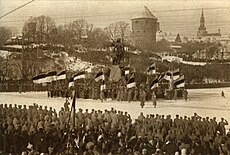Independence Day, formally the Anniversary of the Republic of Estonia (Estonian: Eesti Vabariigi aastapäev), is a national holiday in Estonia commemorating the Estonian Declaration of Independence which was published in the capital city Tallinn (Reval) on 24 February 1918, establishing the Republic of Estonia. Since then, it has been the national day of Estonia.
| Independence Day | |
|---|---|
 Celebration of the first anniversary of Estonian independence in the capital Tallinn (24 February 1919) | |
| Official name | Anniversary of the Republic of Estonia |
| Observed by | Estonian people |
| Significance | Anniversary of the 1918 Estonian Declaration of Independence |
| Celebrations | Concerts, Military parade |
| Date | 24 February |
| Next time | 24 February 2025 |
| Frequency | annual |
Background
editThe Estonian Declaration of Independence, also known as the Manifesto to the Peoples of Estonia was drafted in Tallinn by the Salvation Committee which had been elected by the elders of the Estonian Provincial Assembly. Originally intended to be proclaimed on 21 February 1918, the proclamation was delayed until the evening of 23 February, when the manifesto was printed and announced publicly during a political demonstration in the city of Pärnu. On the next day, 24 February 1918, the manifesto was printed and distributed in the capital, Tallinn.[1][2] At the time, during World War I, as the declaration of independence occurred between retreating Bolshevik Russian and advancing German troops, Tallinn remained free of foreign military presence for only one day, 24 February 1918. During the occupation by the German Empire that followed from the next day, the German Empire did not recognise the newly declared Republic of Estonia. However, after the defeat of the Central Powers in World War I, Germany withdrew its troops from Estonia, and formally handed power in Estonia over to the Estonian Provisional Government in November 1918.[3]
The Estonian Provisional Government decided already on 12 February 1919 to commemorate 24 February as the date of the anniversary of the declaration of independence. In the 1930s, the government discussed whether the national day should be moved to another date at a "better time of the year" (in terms of weather), such as 15 June, to mark the date when the Estonian Constituent Assembly adopted the Constitution in 1920. The date of the national day was never changed.
Celebrations
editThe day begins with the national flag raising ceremony at the Pikk Hermann Tower early in the morning.[4] The President of Estonia organises a festive Independence Day reception at which state decorations are awarded to recipients whose names are published in advance. Since the restoration of Estonian independence in 1991, a new tradition of parades by the Estonia Defence Forces has been established, with the first parade held in Tallinn in 1993 marking the diamond jubilee year since the events of 1918. Both the parade and the reception is held in different years in different cities; in 2014 they were held in Pärnu, and in 2015 in Narva, with that year's parade featuring contingents from fellow NATO member nations. The military parade, the reception and a concert that precedes the reception are broadcast live on television. This coverage includes a speech by the President. As the President's reception is always organized on 24 February, similar receptions by local governments are often held on the previous day, 23 February. Schools and other institutions sometimes hold commemorative Independence Day events even earlier.[citation needed]
Independence Day military parade
editHeld every year 1919–1940, and again since 1993, the annual military parade of the Estonian armed forces is held on Tallinn's Freedom Square. In recent years, typically on the morning of the holiday, the ground column consisting of infantry and armoured formations marching through the square from the Land Forces, Navy, Air Force, and the Defence League form part of the parade. Outside of the military, the police and other cadet and paramilitary youth organizations are represented.
The following organizations send units and formations to the parade:
- Estonian Military Academy (KVÜÕA)
- Baltic Defence College
- Guard Battalion
- Headquarters Support and Signal Battalion of the Küberkaitseliit
- 1st Infantry Brigade
- 2nd Infantry Brigade
- Support Command
- Special Operations Force
- Tallinn Volunteer District of the Estonian Defence League
- Naiskodukaitse (Women's Home Defence)
- Colour guards from NATO and European Union countries
It is often broadcast on major public television station. The parade is traditionally led by the Commander of the Estonian Defence Forces who reports to the President on the status of the parade upon his/her arrival at noon and gives the keynote address after the inspection. Attendees include the Minister of Defence and the Prime Minister of Estonia, as well as members of parliament (Riigikogu).[citation needed]
Gallery
edit-
Independence Day military parade in Tartu (1919)
-
President Konstantin Päts giving a speech on the 20th anniversary of the Republic of Estonia at the Freedom Square, Tallinn (1938).
-
University student organisations setting up flags to celebrate Independence Day in Tartu (2013)
-
Crowds watching the military parade in Tallinn (24 February 2011)
-
A political demonstration in Tallinn on 24 February 2018. The annual event has been organized by EKRE and the Blue Awakening to mark the Independence Day.
-
Soldiers of the Estonian Army's Guard Battalion in the parade (24 February 2018)
See also
editNotes
editReferences
edit- ^ Arjakas, Küllo (23 February 2008). "23. ja 24. veebruar 1918: kuidas iseseisvust kuulutati" (in Estonian). Postimees. Archived from the original on 26 February 2008. Retrieved 24 February 2008.
- ^ Vahtre, Lauri (23 February 2007). "89 aastapäeva – sinimustvalgega ja ilma" (in Estonian). Postimees. Archived from the original on 2 March 2007. Retrieved 24 February 2008.
- ^ Rosenthal, Reigo (3 October 2012). "World War I". Estonica. Archived from the original on 27 June 2017. Retrieved 24 February 2017.
- ^ "February 24 — Estonia's Independence Day!". Visit Estonia. Retrieved 24 February 2023.